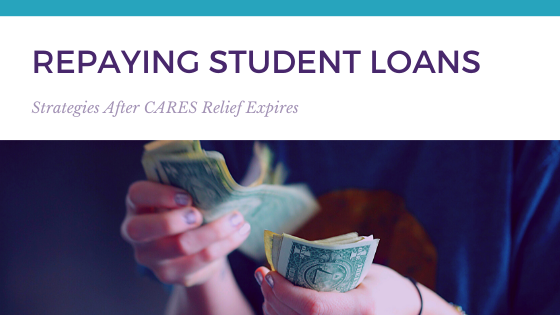Please note an executive order signed 08/08/2020 continues the student loan relief through 12/31/2020. This article has been updated to reflect the new expiration date of specific relief measures.
The CARES Act offers temporary student loan relief for millions of federal student loan borrowers. An executive order signed 8/8/20 extends the relief through the end of the year. Today’s post is all about finding the best repayment strategy after the CARES Act student loan relief expires. If you need the lowest monthly payment, are pursuing forgiveness, or want to pay your loans off ASAP we discuss the options.
Need a quick refresher on the CARES Act temporary student loan relief?
Take Full Advantage of the CARES Act Student Loan Relief
CARES Act Help for Student Loan Default
If you need a low monthly payment.
The coronavirus has resulted in unprecedented job loss and taken a huge toll on personal finances. Plan ahead to avoid last minute stress. You can choose a repayment plan that will have low payments when CARES expires. If you’ve lost your income; your payment can be as low as $0 per month under an income driven repayment plan.
The income-driven repayment plans and extended repayment plan tend to have the lowest payments. The trade off for a low payment is that it takes longer to repay your student loans so you pay more interest over the life of the loan.
- Start by exploring monthly payment estimates on the Federal Student Aid Loan Simulator. Looking at these options doesn’t commit you to changing your repayment plan. Pay attention to the payment amount for the income-driven plans and the extended repayment plan.
- Contact your student loan servicer if you want to switch repayment plans.
- Complete the income-driven repayment plan request form to switch to an income-driven repayment plan.
If you’re counting on loan forgiveness to repay your student loans.
The most important thing to do when pursuing loan forgiveness is to stay on track. You’ll need to resume making eligible payments once the executive order expires 12/31/20. You’ll make payments based on income if you’re pursuing Public Service Loan Forgiveness (PSLF) or Income-Driven Loan Forgiveness. Any repayment plan is eligible for Teacher Loan Forgiveness so choose the one that fits your needs.
- Make sure you know the eligibility requirements for the loan forgiveness program you’re pursuing & take steps to meet them.
- Make sure your income-driven repayment plan is based on your current income. If your income has changed due to job loss, reduced hours, or forced wage decreases, update your income information.
- Submit the Employment Certification Form to check PSLF progress.
If you want to repay your student loans ASAP. Or if you’re repaying private student loans.
Refinancing federal loans after the 0% interest expires can be a good choice if your income hasn’t been significantly impacted, you’re not pursing loan forgiveness, and you want to repay your loans fast. Remember that interest rates are 0% for all federal loans owned by the Department of Education so Refinancing before January 1st 2020 doesn’t make sense, you can’t beat 0%. If you’re unsure about your income, consider making extra payments instead of refinancing to keep federal benefits like income-driven repayment options.
Refinancing private loans could make sense at any time. Private student loans don’t carry the same borrower protections as federal loans so there is little to lose.
- The best interest rates go to borrowers with good to excellent credit scores and high income relative to debt.
- Do some interest rate checking to see if you can get a better interest rate.
- You can get interest rate estimates at several sites including the LendKey marketplace (a partner of Tuition.io) which will show multiple offers at once as well as lenders such as Earnest, SoFi, and CommonBond.
- You’ll need to supply income, liability, & asset information and the site will do a soft credit pull (doesn’t show up on your credit history) to see what type of interest rates you may get offered if you decide to refinance.
- It only makes sense to refinance if the offered interest rate is lower than your current interest rate.
- If you choose to refinance you will select 1-2 of the best offers and submit formal applications which will do a hard credit pull. Once you have formal offers from different companies you can potentially leverage the offers to generate competition and to see if any of your current offers will lower and beat the new interest rates.




